10.1: Introduction to Operations Management
10.1.1: Operations Management
Operations management is the management of processes that transform inputs into goods and services that add value for the customer.
Learning Objective
Explain the role of operations management
Key Points
- The goal of operations management is to maximize efficiency while producing goods and services that effectively fulfill customer needs.
- Operations is one of the three strategic functions of any organization.
- Operations decisions include decisions that are strategic in nature, meaning that they have long-term consequences and often involve a great deal of expense and resource commitments.
Key Terms
- Operations management
-
Management of processes that transform inputs into goods and services that add value for the customer.
- tactic
-
A maneuver or action calculated to achieve some end.
- strategy
-
A plan of action intended to accomplish a specific goal.
Examples
- JetBlue airlines is a successful airline that has an organization strategy of providing high-value air transportation service to travelers. JetBlue strives to provide fun, comfortable, and safe air service to popular destinations at a price that middle-income passengers can afford. Given JetBlue’s organization strategy, the airline features an operations strategy that focuses on low costs, competent and service-oriented employees, and reliable aircraft.
- JetBlue locates (“location” is an operations decision area) its main transportation hub in New York City, a city of 19 million people that helps ensure that JetBlue’s planes fly at full capacity. In the area of equipment decisions, JetBlue operates only one type of aircraft, the Airbus 320, which has high passenger carrying capacity (to maximize revenue), provides good fuel economy and requires only two pilots (versus three) to operate. Having one type of aircraft reduces training costs for pilots and mechanics, reduces investments in parts inventories, and enables JetBlue to negotiate greater discounts on high-volume purchases from Airbus.
What is Operations Management?
Operations management is the management of processes that transform inputs into goods and services that add value for the customer.
The Goal of Operations Management
The goal of operations management is to maximize efficiency while producing goods and services that effectively fulfill customer needs.
Countless operating decisions must be made that have both long- and short-term impacts on the organization’s ability to produce goods and services that provide added value to customers. If the organization has made mostly good operating decisions in designing and executing its transformation system to meet the needs of customers, its prospects for long-term survival are greatly enhanced.
For example, if an organization makes furniture, some of the operations management decisions involve the following:
- purchasing wood and fabric,
- hiring and training workers,
- location and layout of the furniture factory,
- purchase cutting tools and other fabrication equipment.
If the organization makes good operations decisions, it will be able to produce affordable, functional, and attractive furniture that customers will purchase at a price that will earn profits for the company.
The Role of Operations Management in the Organization
Operations is one of the three strategic functions of any organization. This means that it is a vital part of accomplishing the organization’s strategy and ensuring its long-term survival. The other two areas of strategic importance to the organization are marketing and finance. The operations strategy should support the overall organization strategy. Many companies prepare a 5-year pro-forma to assist in their operation planning. The pro forma uses information from past and current financial statements in an effort to predict future events such as sales, and capital investments.
Strategic Versus Tactical Operations Decisions
Operations decisions include decisions that are strategic in nature, meaning that they have long-term consequences and often involve a great deal of expense and resource commitments.
Strategic operations decisions include the following:
- facility location decisions,
- the type of technologies that the organization will use,
- determining how labor and equipment are organized,
- how much long-term capacity the organization will provide to meet customer demand.
Tactical operations decisions have short to medium term impact on the organization, often involve less commitment of resources, and can be changed more easily than strategic decisions. The following are some tactical decisions:
- workforce scheduling,
- establishing quality assurance procedures,
- contracting with vendors,
- managing inventory.
Strategic and tactical operations decisions determine how well the organization can accomplish its goals. They also provide opportunities for the organization to achieve unique competitive advantages that attract and keep customers.
For example, United Parcel Service (UPS), an international package delivery service, formed a partnership with its customer, Toshiba computers. Toshiba needs to provide a repair service to its laptop computer customers. The old approach of providing this service was cumbersome and time-consuming:
- UPS picked up the customer computers.
- UPS delivered the computers to Toshiba.
- Toshiba repaired the computers.
- UPS picked up the repaired computers and delivered them back to the customers.
Under this traditional approach, the total time to get a laptop computer repaired was two weeks—a long time for people to be without their laptop! Then they came up with an innovative idea for Toshiba to provide better service to its customers.
UPS hired, trained, and certified its own employees to repair Toshiba laptop computers. The new repair process is much more efficient:
- UPS picks up computers from Toshiba owners.
- UPS repairs the computers.
- UPS delivers the computers back to their owners.
The total time to get a computer repaired is now about two days.
Most Toshiba customers think that Toshiba is doing a great job of repairing their computers, when in fact Toshiba never touches the computers! The result of this operations innovation is better service to Toshiba customers and a strong and profitable strategic partnership between UPS and its customer, Toshiba.
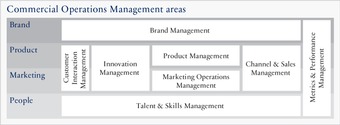
Operations Management
Blueprint for a commercial operations management solution.
10.1.2: A Study of Process
Operations management transforms inputs (labor, capital) into outputs (goods and services) that provide added value to customers.
Learning Objective
Analyze the importance of operations management in protecting an organization’s competitive advantage
Key Points
- Operations management transforms inputs (labor, capital, equipment, land, buildings, materials, and information) into outputs (goods and services) that provide added value to customers.
- All organizations must strive to maximize the quality of their transformation processes to meet customer needs.
- Controlling the transformation process makes it difficult for competitors to manufacture products of the same quality as the original producer.
Key Terms
- process
-
A series of events to produce a result, especially as contrasted to product.
- input
-
Something fed into a process with the intention of it shaping or affecting the outputs of that process.
- output
-
Production; quantity produced, created, or completed.
Examples
- The 3M Company is a good example of the strategic importance of transforming inputs into outputs that provide competitive advantage in the marketplace. This company manufactures a top-quality adhesive tape called “Magic Tape. ” Magic Tape is used for everyday taping applications, but it offers attractive features that most other tapes do not, including smooth removal from the tape roll, an adhesive that is sticky enough to hold items in place (but not too sticky that it can not be removed and readjusted, if necessary! ), and a non-reflective surface. For several decades, 3M has enjoyed a substantial profit margin on its Magic Tape product, because 3M engineers make the manufacturing equipment and design the manufacturing processes that produce Magic Tape. In other words, 3M enjoys a commanding competitive advantage by controlling the transformation processes that turn raw material inputs into the high value-added Magic Tape product. Controlling the transformation process makes it extremely difficult for competitors to produce tape of the same quality as Magic Tape, allowing 3M to reap significant profits from this superior product.
- An opposite example of the strategic implications of the input/output transformation process is 3M’s decision in the 1980s to stop manufacturing VHS tape for video players and recorders. In the VHS tape market, 3M had no proprietary manufacturing advantage, as there were many Asian competitors that could produce high-quality, VHS tape at lower cost. Since 3M had no proprietary control over the transformation process for VHS tape that would allow the company to protect its profit margins for this product, it dropped VHS tape from its offerings. The two 3M examples of Magic Tape and VHS tape show how important the transformation process and operations management can be to providing and protecting an organization’s competitive advantage.
Operations Management and the Transformation Process
Operations management transforms inputs (labor, capital, equipment, land, buildings, materials and information) into outputs (goods and services) that provide added value to customers.
Figure 1 summarizes the transformation process. The arrow labeled “Transformation System” is the critical element in the model that will determine how well the organization produces goods and services that meet customer needs. It does not matter whether the organization is a for-profit company, a non-profit organization (religious organizations, hospitals, etc.), or a government agency; all organizations must strive to maximize the quality of their transformation processes to meet customer needs.
Example: Strategic Importance of Operations Management
The 3M Company is a good example of the strategic importance of transforming inputs into outputs that provide competitive advantage in the marketplace.
3M manufactures a top-quality adhesive tape called “Magic Tape”. Magic Tape is used for everyday taping applications, but it offers attractive features that most other tapes do not, including:
- Smooth removal from the tape roll
- An adhesive that is sticky enough to hold items in place (but not too sticky that it can not be removed and readjusted if necessary! )
- A non-reflective surface
For several decades, 3M has enjoyed a substantial profit margin on its Magic Tape product because 3M engineers make the manufacturing equipment and design the manufacturing processes that produce Magic Tape. In other words, 3M enjoys a commanding competitive advantage by controlling the transformation processes that turn raw material inputs into the high value-added Magic Tape product.
Controlling the transformation process makes it extremely difficult for competitors to produce tape of the same quality as Magic Tape, allowing 3M to reap significant profits from this superior product.
An opposite example of the strategic implications of the input/output transformation process is 3M’s decision in the 1980s to stop manufacturing VHS tape for video players and recorders.
In the VHS tape market 3M had no proprietary manufacturing advantage, as there were many Asian competitors that could produce high-quality VHS tape at lower cost. Since 3M had no proprietary control over the transformation process for VHS tape that would allow the company to protect its profit margins for this product, it dropped VHS tape from its offerings.
The two 3M examples of Magic Tape and VHS tape show how important the transformation process and operations management can be to providing and protecting an organization’s competitive advantage.
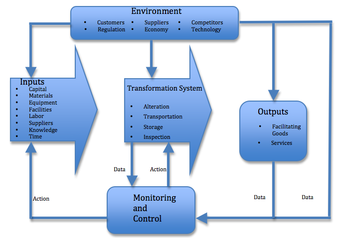
Example of a typical transformation process
10.1.3: Service Operations
Services operations often encounter different opportunities and challenges than tangible goods, and thus require unique operational considerations.
Learning Objective
Identify the key differences between services and other types of goods, and recognize the operational implications of these differences
Key Points
- Service operations are the operational strategies and tactics which go into delivering an intangible good to prospective consumers.
- Understanding this field of work requires an understanding of what a service constitutes. One useful perspective in differentiating services from other goods is the ‘5 I’s of services’ perspective.
- As services behave somewhat differently than tangible products, operations managers must take into account different considerations when optimizing their operational strategy.
- Improving overall quality through measuring consumer satisfaction, planning facilities for optimal use of space, and effective scheduling are a few examples of considerations service operators consider.
Key Terms
- NPS surveys
-
Management tools that can be used to gauge the loyalty of a firm’s customer relationships. It serves as an alternative to traditional customer satisfaction research and claims to be correlated with revenue growth.
- opportunity costs
-
The overall cost of something missed; through deciding to do ‘A’, an individual or organization incurs the opportunity cost of doing ‘B’.
- Intangibility
-
The state of not being touchable. For example, an idea is real, but not tangible.
Service operations are simply the application of operations management to an intangible good (i.e. a service). To understand how service operations function, let’s first take a look at what is considered a service.
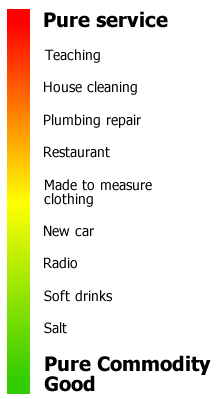
Service-Goods Continuum
This simple line graph shows industries that are nearly 100% service-related at the top and industries that are nearly 100% product-related at the bottom. It is an illustration of how the service-product continuum is more of a spectrum than a black and white rule.
Services Defined
An easy way to remember what a service is (compared to a product) is through using the ‘5 I’s of Services’:
- Intangibility – Services cannot be touched, shipped, handled, or looked at. They are an occurrence, not a tangible good.
- Inventory – Services cannot be stored for later use. They occur, or they do not occur.
- Inseparability – Services cannot be pulled into different parts or separated (as many tangible goods can be—which makes operations management quite different for products).
- Inconsistency – Services tend to be unique. A teacher may teach you a topic, and another teacher may teach you the same topic in another course. Each teacher will deliver this topic somewhat differently. This is a good example of service inconsistency.
- Involvement – Consumers are often directly involved in the service delivery. A therapist is a good example of this. The consumer is the center of the service, and thus each instance of the service is unique based on the individual involved.
Managing Service Operations
This definition offers a great deal of insight when applied to the concept of operational management. Without a tangible good to ship, handle and produce, operational managers are instead focused on the execution of an activity to fill a consumer need. This management of an instance is rather different than the management of a product.
Managing operations is just as critical on the service side as it is on the product side. While there are countless considerations to be made, many of which are unique to specific organizations or industries, these core operational decisions are strong indications of the mentality service management specialists consider:
Location
Choosing where to open a facility, how to lay out the facility, what size is appropriate, and overall how efficiently a given space can be used relative to the cost are key considerations. Consider a car mechanic opening a garage. Depending upon how many jobs she anticipates having within a given period of time, and how many employees she expects to be able to manage simultaneously, she may want to open a facility with three garages or five garages. It really depends on how much output she expects she can accomplish, and how much input demand will provide.
Scheduling
Just as a product manufacturing facility will know when a product will be where, so too do service operators need to know when a given service should start and what duration of time is required to complete it. Maximizing output through planning properly can minimize opportunity costs and maximize revenue, and plays an integral role in operational management of services. Take a doctor’s office. If they simply had everyone come in whenever they wanted, there would be times when the staff would have nothing to do (but be obligated to be there, and be paid), and other times when there would be too much to do and capital and customers would be lost.
Quality
As the ‘5 I’s of Services’ indicate, most services tend to be completely unique. A hair dresser rarely gives the same haircut twice and, even if they do, it would be cut to fit a different individual. As a result, managing for high quality output is rather complex. Each execution is measured relative to the specific instance and that specific consumer, making tools like NPS surveys and other measures of individual satisfaction highly useful in optimizing. Following these ratings, operational specialists must consider the comments received and work to find a way to integrate this feedback into future services.
10.2: Quality Management
10.2.1: Philosophies
Quality management adopts a number of management principles that can be used to guide organizations towards improved performance.
Learning Objective
Recognize how top management can improve quality performance
Key Points
- There are eight primary quality management principles.
- The principles are the basis of the ISO 9001:2008 quality management system standard.
- One of the permanent quality objectives of an organization should be the continual improvement of its overall performance.
Key Terms
- Quality Management
-
Process of ensuring that an organization or product is consistent. It can be considered to have four main components: quality planning, quality control, quality assurance, and quality improvement. Quality management is focused not only on product/service quality, but also the means to achieve it.
- value
-
The degree of importance you give to something.
- ISO 9001:2008
-
The ISO 9000 family of standards are related to quality management systems and designed to help organizations ensure that they meet the needs of customers and other stakeholders while meeting statutory and regulatory requirements related to the product.
Example
- In the 1950s and 1960s, Japanese goods were synonymous with cheapness and low quality but over time, their quality initiatives began to be successful, with Japan achieving very high levels of quality in products from the 1970s onward. For example, Japanese cars regularly top the J.D. Power customer satisfaction ratings. In the 1980s, Deming was asked by Ford Motor Company to start a quality initiative after they realized that they were falling behind Japanese manufacturers. A number of highly successful quality initiatives have been invented by the Japanese (see for example, on this page: Genichi Taguchi, QFD, Toyota Production System. Many of the methods not only provide techniques but also have associated quality culture (i.e., people factors). These methods are now adopted by the same western countries that decades earlier derided Japanese methods.
The Principles of Quality Management
Quality management adopts a number of management principles that can be used by top management to guide their organizations towards improved performance. The principles include:
- Customer focus: Since the organizations depend on their customers, they should understand current and future customer needs, should meet customer requirements, and try to exceed the expectations of customers. An organization attains customer focus when all people in the organization know both the internal and external customers and also what customer requirements must be met to ensure that both the internal and external customers are satisfied.
- Leadership: Leaders of an organization establish unity of purpose and direction of it. They should go for creation and maintenance of such an internal environment, in which people can become fully involved in achieving the organization’s quality objective.
- Involvement of people: People at all levels of an organization are the essence of it. Their complete involvement enables their abilities to be used for the benefit of the organization.
- Process approach: The desired result can be achieved when activities and related resources are managed in an organization as process.
- System approach to management: An organization’s effectiveness and efficiency in achieving its quality objectives are contributed by identifying, understanding, and managing all interrelated processes as a system.
- Continual improvement: One of the permanent quality objectives of an organization should be the continual improvement of its overall performance.
- Factual approach to decision making: Effective decisions are always based on the data analysis and information.
- Mutually beneficial supplier relationships: Since an organization and its suppliers are interdependent, therefore, a mutually beneficial relationship between them increases the ability of both to add value.
These eight principles form the basis for the quality management system standard ISO 9001:2008.
10.2.2: TQM
Total quality management (TQM) is an integrative philosophy of management for continuously improving the quality of products and processes.
Learning Objective
Explain the principles of Total Quality Management (TQM)
Key Points
- TQM functions on the premise that the quality of products and processes is the responsibility of everyone who is involved with the creation or consumption of the goods or services offered by an organization.
- Satisfying the customer involves making sure both internal and external customers are happy.
- The internal suppliers are the subordinates who answer to a particular supervisor. Satisfying them involves giving them the tools and motivation they need to do their jobs.
- It is important to go beyond satisfaction, making the customer – and supplier – feel important and valued, and part of the process.
- “Lean” focuses on eliminating the wasteful use of time, energy or resources, and instead focusing activities completely on the creation of value.
- The focus of the Six Sigma management strategy is to reduce defect by minimizing variation in processes.
Key Terms
- poka-yoke
-
A methodology of using low-cost techniques to error-proof production processes.
- Total Quality Management (TQM)
-
A strategic approach to management aimed at embedding awareness of quality in all organizational processes.
Example
- ‘Lean’ is based on the Toyota Production System, which aimed to minimize overburden, inconsistency and waste. It was developed between 1948-1975, and was a precursor to lean manufacturing.
Total Quality Management (TQM) is an integrative philosophy of management for continuously improving the quality of products and processes .

TQM Practices Are Used in Many Industries
Here, two aviation structural mechanics are collaborating on the wing of a F/A-18C Hornet, performing routine maintenance in the hangar bay. TQM practices ensure each person involved with a product is responsible for its quality.
Overview
TQM functions on the premise that the quality of products and processes is the responsibility of everyone involved in the creation or consumption of the goods or services the organization offers. TQM capitalizes on the involvement of management, the workforce, suppliers, and even customers in order to meet or exceed customer expectations.
Considering the practices of TQM as discussed in six empirical studies, Cua, McKone, and Schroeder (2001) identified nine common TQM practices:
- Cross-functional product design;
- Process management;
- Supplier quality management;
- Customer involvement;
- Information and feedback;
- Committed leadership;
- Strategic planning;
- Cross-functional training; and
- Employee involvement.
Basic Principles of Total Quality Management
The basic principles for the Total Quality Management philosophy of doing business are to satisfy the customer, satisfy the supplier, and continuously improve the business processes.
Satisfy the Customer
The first, and major, TQM principle is to satisfy the customer–the person who pays for the product or service. Customers want to get their money’s worth from a product or service they purchase.
Satisfy the Users: If the user of the product is different than the purchaser, then both the user and customer must be satisfied, although the person who pays gets priority.
Company Philosophy: A company that seeks to satisfy the customer by providing them value for what they buy and the quality they expect will get more repeat business, referral business, and reduced complaints and service expenses. Some top companies not only provide quality products but also give extra service to make their customers feel important and valued.
Internal Customers: Within a company, a worker provides a product or service to his or her supervisors. If the person has any influence on the wages the worker receives, that person can be thought of as an internal customer. A worker should have the mindset of satisfying internal customers in order to keep his or her job and to get a raise or promotion.
Chain of Customers:Often in a company, there is a chain of customers–each improving a product and passing it along until it is finally sold to the external customer. Each worker must not only seek to satisfy the immediate internal customer, but must also look up the chain to try to satisfy the ultimate customer.
Satisfy the Supplier
A second TQM principle is to satisfy the supplier, which is the person or organization from whom you are purchasing goods or services.
External Suppliers: A company must look to satisfy their external suppliers by providing them with clear instructions and requirements and then paying them fairly and on time. It is in the company’s best interest that its suppliers provide quality goods or services if the company hopes to provide quality goods or services to its external customers.
Internal Suppliers: A supervisor must try to keep workers happy and productive by providing good task instructions, the tools they need to do their job, and good working conditions. The supervisor must also reward the workers with praise and good pay.
Get Better Work: The reason to do this is to get more productivity out of the workers, as well as to keep the good workers. An effective supervisor with a good team of workers will certainly satisfy his or her internal customers.
Empower Workers: One area of satisfying the internal suppler is by empowering the workers. This means allowing them to make decisions on things that they can control. This not only takes the burden off the supervisor, but it also motivates these internal suppliers to do better work.
Continuous Improvement
The third principle of TQM is continuous improvement. You can never be satisfied with the method used, because there always can be improvements. The competition is always improving, so it is necessary to strive to keep ahead of the game.
Work Smarter, Not Harder: Some companies have tried to improve by making employees work harder. This may be counterproductive, especially if the process itself is flawed. For example, trying to increase worker output on a defective machine may result in more defective parts. Examining the source of problems and delays and then solving those problems is what works best. Often, the process has bottlenecks that are the real cause of the problem. Those are what should be removed.
Worker Suggestions: Workers are often a source of continuous improvements. They can provide suggestions on how to improve a process and eliminate waste or unnecessary work.
Quality Methods: There are also many quality methods, such as just-in-time production, variability reduction, and poka-yoke, that can improve processes and reduce waste.
10.2.3: Quality Inspections and Standards
Companies ensure the quality of products and services by adhering to ISO standards and performing quality audits to ensure compliance.
Learning Objective
Recognize the ISO’s role in ensuring quality standards
Key Points
- The Quality Management System (QMS) standards were created by the International Organization for Standardization (ISO) in 1987, and are reviewed and updated every few years. These standards are used to certify the processes and systems of an organization, but not the product or service itself.
- In 1994 three major standards were released as part of the ISO 9000:1994 series. Major revisions were made in 2008.
- A quality audit is the systematic examination of a quality system, and is carried out by internal or external auditors. It is a key element in ISO 9001 standards.
- Since 2008, the focus of quality audits has shifted from simply procedural adherence to measuring the effectiveness of actual QMS’s.
Key Terms
- ISO 9000
-
a set of standards related to quality management systems and designed to help organizations ensure that they meet the needs of customers and other stakeholders while meeting statutory and regulatory requirements related to the product
- Quality Management System (QMS)
-
The organizational structure, procedures, processes, and resources needed to implement quality management.
- Quality Audit
-
The process of systematic examination of a quality system carried out by an internal or external quality auditor or audit team. It is an important part of an organization’s quality management system and is a key element in the ISO quality system standard, ISO 9001.
- International Organization for Standardization (ISO)
-
An international standard-setting body composed of representatives from various national standards organizations. Founded on February 23, 1947, the organization promulgates worldwide proprietary, industrial, and commercial standards.
- ISO 14000
-
a set of standards related to environmental management designed to help organizations reduce the negative environmental effect of their operations, meet legal requirements, and continually improve
Example
- Quality audits and adherence to ISO standards are not just for private corporations; the US Food and Drug Administration requires that medical devices undergo quality auditing, and several countries require quality audits of their educational systems.
Quality Standards
The International Organization for Standardization (ISO) created the Quality Management System (QMS) standards in 1987. They were the ISO 9000:1987 series of standards, comprising ISO 9001:1987, ISO 9002:1987, and ISO 9003:1987; which were applicable in different types of industries, based on the type of activity or process (designing, production, or service delivery).
The standards are reviewed every few years by the ISO. The version in 1994 was called the ISO 9000:1994 series; consisting of the ISO 9001:1994, 9002:1994 and 9003:1994 versions.
A major revision occurred in 2008, and the series was called ISO 9000:2000 series. The ISO 9002 and 9003 standards were integrated into one single certifiable standard: ISO 9001:2008. After December 2003, organizations holding ISO 9002 or 9003 standards had to complete a transition to the new standard.
The ISO 9004:2009 document gives guidelines for performance improvement over and above the basic standard (ISO 9001:2000). This standard provides a measurement framework for improved quality management, similar to and based upon the measurement framework for process assessment.
The Quality Management System standards created by ISO are meant to certify the processes and the system of an organization, not the product or service itself. ISO 9000 standards do not certify the quality of the product or service.
In 2005 the International Organization for Standardization released a standard, ISO 22000, meant for the food industry. This standard covers the values and principles of ISO 9000 and the HACCP standards. It gives one single integrated standard for the food industry and is expected to become more popular in the coming years in the industry.
ISO has also released standards for other industries. For example, Technical Standard TS 16949 defines requirements in addition to those in ISO 9001:2008 specifically for the automotive industry.
ISO has a number of standards that support quality management. One group describes processes (including ISO/IEC 12207 & ISO/IEC 15288), and another describes process assessment and improvement (ISO 15504).
Quality Audits
A quality audit is the process of systematic examination of a quality system carried out by an internal or external quality auditor or audit team. It is an important part of organization’s quality management system and is a key element in the ISO quality system standard, ISO 9001.
Quality audits are typically performed at predefined time intervals and ensure that the institution has clearly defined internal system monitoring procedures linked to effective action. This can help determine if the organization complies with the defined quality system processes and can involve procedural or results-based assessment criteria.

Quality Check
Quality assurance inspectors regularly perform audits.
With the upgrade of the ISO 9000 series of standards from the 1994 to 2008 series, the focus of the audits has shifted from purely procedural adherence towards measurement of the actual effectiveness of the Quality Management System (QMS) and the results that have been achieved through the implementation of a QMS.
Audits are an essential management tool to be used for verifying objective evidence of processes, to assess how successfully processes have been implemented, for judging the effectiveness of achieving any defined target levels, to provide evidence concerning reduction and elimination of problem areas.
For the benefit of the organisation, quality auditing should not only report non-conformance and corrective actions, but also highlight areas of good practice. In this way, other departments may share information and amend their working practices, which contributes to continual improvement.
Quality audits can be an integral part of compliance or regulatory requirements. One example is the US Food and Drug Administration, which requires quality auditing to be performed as part of its Quality System Regulation (QSR) for medical devices (Title 21 of the US Code of Federal Regulations part 820).
Several countries have adopted quality audits in their higher education system (including New Zealand, Australia, Sweden, Finland, Norway, and the USA). Initiated in the UK, the process is focused primarily on procedural issues rather than on the results or the efficiency of a quality system implementation.
Audits can also be used for safety purposes. Evans and Parker (2008) describe auditing as one of the most powerful safety monitoring techniques and “an effective way to avoid complacency and highlight slowly deteriorating conditions,” especially when the auditing focuses not just on compliance but effectiveness.
The processes and tasks that a quality audit involves can be managed using a wide variety of software and self-assessment tools. Some of these relate specifically to quality in terms of fitness for purpose and conformance to standards, while others relate to quality costs or (more accurately) to the cost of poor quality. In analyzing quality costs, a cost of quality audit can be applied across any organization rather than just to conventional production or assembly processes.
10.2.4: Reducing Waste and Environmental Impacts
Reducing waste by more efficient manufacturing is a key goal of management, with supply chain sustainability seen as a key component.
Learning Objective
Explain the benefits of reducing waste
Key Points
- Waste minimization is often achieved through more efficient manufacturing processes and the usage of better materials, but often requires some initial investment.
- Governments often provide incentives to companies for waste minimization, including subsidies and reduced taxes for companies that take steps to reduce waste.
- A more sustainable supply chain is increasingly seen as leading to a more profitable supply chain, and, thus, managers are increasingly looking for ways to make their supply chains more sustainable.
- Collaboration is seen as a way of achieving the goal of supply chain sustainability.
- Many companies avoid collaboration due to a fear of a loss of commercial control.
Key Terms
- Supply Chain Sustainability
-
An essential component to delivering long-term profitability. It has replaced monetary cost, value, and speed as the dominant topic of discussion among purchasing and supply professionals.
- Collaboration
-
Working together to achieve a common goal.
Example
- Wal-Mart asked suppliers to be more efficient in their deliveries through it’s Supplier Energy Efficiency Project (SEEP). As a result, suppliers reduced GHG emissions by 3,300 metric tons and saved $200,000 in energy costs.
Reducing Waste: The Incentives
In industrial production, using more efficient manufacturing processes and better materials will generally reduce the production of waste. The application of waste minimization techniques has led to the development of innovative and commercially successful replacement products. Waste minimization has proven benefits to industry and the wider environment.
Waste minimization often requires investment, which is, at least in theory, usually compensated by the savings. However, waste reduction in one part of the production process may create waste production in another part.
There are government incentives for waste minimization, which focus on the environmental benefits of adopting waste minimization strategies.
In the United Kingdom, several pilot schemes, such as The Catalyst Project and the Dee Waste Minimisation Project, have shown the efficacy of such policies. Fourteen companies in Merseyside took part in the Catalyst Project; the project generated overall savings of £9 million and landfill waste was reduced by 12,000 tonnes per year. ).

Colorful recycling containers
By producing using materials that are recyclable, landfill waste can be minimized.
Supply Chain Sustainability
Supply chain sustainability is a business issue affecting an organization’s supply chain or logistics network in terms of environmental, risk, and waste costs.
Sustainability in the supply chain is increasingly seen among high-level executives as essential to delivering long-term profitability and has replaced monetary cost, value, and speed as the dominant topic of discussion among purchasing and supply professionals.
One of the key requirements of successful sustainable supply chains is collaboration. The practice of collaboration, such as sharing distribution to reduce waste by ensuring that half-empty vehicles do not get sent out and that deliveries to the same address are on the same truck, is not widespread because many companies fear a loss of commercial control by working with others.
Investment in alternative modes of transportation, such as use of canals and airships, can play an important role in helping companies reduce the cost and environmental impact of their deliveries.
Sustainability has been found to be a major component of supplier relationship management as an efficient way to cut costs among retailer giants such as Wal-Mart. In fact, under Wal-Mart’s Supplier Energy Efficiency Project (SEEP), which is aimed at eliminating emissions from the company’s supply chain, suppliers reduced GHG emissions by 3,300 metric tons and saved $200,000 in energy costs.
Realizing the efficiency that effective supplier relationship management creates, Wal-Mart has asked suppliers to be more efficient in managing their environmental footprint.
Looking to the supply chain to maximize efficiency and cut costs is a key cost-cutting measure; using the same suppliers in a tight-knit relationship saves time and energy. As industry leaders continue to add in cost-cutting measures, we are likely to see this trend continue in supply chain sustainability for sustained improvement in relationship building and cost reduction.
10.3: Productivity
10.3.1: Impacts of Productivity on Output
Productivity, or the efficiency of production, is important because it can drive increases in output and improvements in living standards.
Learning Objective
Develop a model to measure productivity
Key Points
- Productivity is generally measured as the ratio of the total output to total input.
- In an economy, higher productivity leads to higher real income, the ability to enjoy more leisure time, and better social services, such as health and education–all leading to higher living standards.
- Surplus value refers to the difference between returns and costs. The higher is surplus value; the more productive is the process.
- Small differences in productivity between countries can compound, leading to large differences in prosperity in the long run.
Key Terms
- Surplus value
-
The part of the new value made by production that is taken by enterprises as generic gross profit.
- productivity
-
The state of being productive, fertile, or efficient; the rate at which goods or services are produced by a standard population of workers.
Example
- From 1964-65 to 1999-2000, labor productivity in Australia’s market sector grew at a compound annual rate of 2.4%. The contribution of growing capital intensity of IT to growth in labor productivity has been generally rising over time. Indeed, during the latter part of the 1990s, it accounted for the bulk of the contribution of rising capital intensity and has clearly played a major role in the growth of Australia’s labor productivity. Thus, the growth in labor productivity, and the role of IT in this, has clearly been a factor in Australia’s continued competitiveness in the global economy.
Defining Productivity
Productivity is a measure of the efficiency of production. Productivity is a ratio of production output to what is required to produce it (inputs). The measure of productivity is defined as a total output per one unit of a total input.

Productivity
Productivity is a measure of the efficiency of production.
In order to obtain a measurable form of productivity, operationalization of the concept is necessary. In explaining and operationalizing, a set of production models are used. A production model is a numerical expression of the production process that is based on production data (i.e., measured data in the form of prices and quantities of inputs and outputs0.
Production Income Model
There are no criteria that might be universally applicable to success. Nevertheless, there is one criterion by which we can generalize the rate of success in production. This criterion is the ability to produce surplus value.
As a criterion of profitability, surplus value refers to the difference between returns and costs, taking into consideration the costs of equity in addition to the costs included in the profit and loss statement as usual. Surplus value indicates that the output has more value than the sacrifice made for it; in other words, the output value is higher than the value (production costs) of the used inputs. If the surplus value is positive, the owner’s profit expectation has been surpassed.
Impact on Output
When there is productivity growth, even the existing commitment of resources generates more output and income. Income generated per unit of input increases. Additional resources are also attracted into production and can be profitably employed.
At the national level, productivity growth raises living standards because more real income improves people’s ability to purchase goods and services (whether they are necessities or luxuries), enjoy leisure, improve housing and education and contribute to social and environmental programs.
Over long periods of time, small differences in rates of productivity growth compound, such as interest in a bank account, and can make an enormous difference to a society’s prosperity. Nothing contributes more to the reduction of poverty, increases in leisure, and to the country’s ability to finance education, public health, environment, and the arts.
10.3.2: Productivity Gains from Software
New ways of developing and using software have led to higher efficiency and productivity through greater interaction between users.
Learning Objective
Explain how collaborative software increases productivity
Key Points
- Collaborative software, or groupware, puts computers in the center of communications between groups of workers, managers, and technicians. This way of working has produced major gains in productivity since it was first introduced.
- Examples of collaborative software include document sharing, shared calendars, instant messaging, and web conferencing.
- In agile software development, solutions arise through collaboration between self-organizing, cross-functional teams. It involves adaptive planning and flexbile responses: tasks are broken into small increments with minimal longer-term planning, and responses evolve to problems as they arise.
- The values espoused in the Agile Manifesto focus on people and functionality, rather than rigidity, documentation, and planning. It is thought that better, more useful software can be developed with these values.
Key Terms
- Agile software development
-
A group of software development methods based on iterative and incremental development, where requirements and solutions evolve through collaboration between self-organizing, cross-functional teams. The basic idea behind the agile method is to develop a system through repeated cycles (iterative) and in smaller portions at a time (incremental), allowing software developers to take advantage of what was learned during development of earlier parts or versions of the system.
- Collaborative software
-
Computer software designed to help people involved in a common task achieve goals.
Example
- Google Docs are a particularly popular and easy to use set of collaborative softwares. Users can link their calendars, and work on documents, spreadsheets, or presentations simultaneously and in real time. The simplicity and availability of Google Docs make them particularly popular.
Collaborative Software
Collaborative software was originally designated as groupware and this term can be traced as far back as the late 1980s, when Richman and Slovak said, “Like an electronic sinew that binds teams together, the new groupware aims to place the computer squarely in the middle of communications among managers, technicians, and anyone else who interacts in groups, revolutionizing the way they work. “
Collaborative software has produced major gains in productivity. The definition of an office has dramatically changed as an individual is able to work efficiently as a member of a group wherever there is a computer (or an iPad, or iPhone, or Blackberry) .
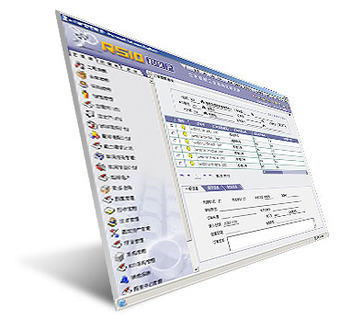
Software
Collaborative software has produced major gains in productivity.
Examples of the major gains include:
- Document sharing (including group editing)
- Group calendars
- Instant messaging
- Web conferencing
Agile Software Development
Agile software development is a group of software development methods based on iterative and incremental development, where requirements and solutions evolve through collaboration between self-organizing, cross-functional teams.
It promotes adaptive planning, evolutionary development and delivery, a time-boxed iterative approach, and encourages rapid and flexible response to change. It is a conceptual framework that promotes foreseen interactions throughout the development cycle.
Agile methods break tasks into small increments with minimal planning and do not directly involve long-term planning.
Iterations are short time frames (timeboxes) that typically last from one to four weeks. Each iteration involves a team working through a full software development cycle when a working product is demonstrated to stakeholders. The development cycle includes:
- Planning
- Requirements analysis
- Design
- Coding
- Unit testing
- Acceptance testing
This approach minimizes overall risk and allows the project to adapt to changes quickly. Stakeholders produce documentation as required.
An iteration might not add enough functionality to warrant a market release, but the goal is to have an available release (with minimal bugs) at the end of each iteration. Multiple iterations might be required to release a product or new features.
According to the Agile Manifesto:
Through this work we have come to value: individuals and interactions over
processes
and tools; working software over comprehensive documentation; customer collaboration over contract negotiation; responding to change over following a plan. That is, while there is value in the items on the
right
, we value the items on the left more.
10.3.3: Productivity Gains from Hardware
Productivity improving technologies lower traditional factors of production of land, labor capital, materials, and energy.
Learning Objective
Outline the progression of productivity improving technologies in the 20th century
Key Points
- Productivity gains were not just the result of inventions, but also of continuous improvements to those inventions which greatly increased output in relation to both capital and labor compared to the original inventions.
- The technology of building mills and mechanical clocks was important to the development of the machines of the Industrial Revolution.
- Machine tools–which cut, grind, and shape metal parts–were another important mechanical innovation of the Industrial Revolution.
- The evolution of hardware has allowed computing to become widespread due to its low cost and effectiveness. Microchips are now used in everything from greeting cards to missile defense systems.
Key Terms
- Industrial Revolution
-
The major technological, socioeconomic, and cultural change in the late 18th and early 19th century, resulting from the replacement of an economy based on manual labor to one dominated by industry and machine manufacture.
- cloud
-
Regarded as an amorphous omnipresent space for processing and storage on the Internet; the focus of cloud computing.
Example
- In the 1990s, one could buy an IBM desktop computer with a 486 processor, 4 megabytes of RAM, 250 megabytes HDD, and a 3.5″ floppy disk for more than you would pay today for a top-of-the-range ultra lightweight laptop with an Intel Core i7 processor, 8GB of RAM, 1TB HDD, and a Blu-Ray player. This progression in hardware technology, coupled with huge drops in cost, has allowed almost anyone to have access to these technologies. Even in the developing world, ultra low-cost laptops have been designed to allow children in poor communities to learn about and use modern technologies.
Productivity Improving Technologies
Productivity improving technologies are technologies that lower the traditional factors of production of land, labor capital, materials, and energy that go into production of economic output. Increases in productivity are responsible for increases in per capita living standards. Since the beginning of the Industrial Revolution, some major contributors to productivity have been:
- The spinning jenny and spinning mule greatly increased the productivity of thread manufacturing compared to the spinning wheel.
- Replacing human and animal power with water power, wind power, steam, electricity, and internal combustion greatly increased the use of energy.
- Energy efficiency in the conversion of energy to useful work.
- Infrastructures: canals, railroads, highways, and pipelines.
- Mechanization of both production machinery and agricultural machines.
- Work practices and processes: the American system of manufacturing, Taylorism or scientific management, mass production, assembly line, modern business enterprise.
- Materials handling: bulk materials, palletization, and containerization.
- Scientific agriculture: fertilizers and the green revolution, livestock and poultry management.
- New materials, new processes for production and dematerialization.
- Communications: telegraph, telephone, radio, satellites, fiber optic network, and the Internet.
- Home economics: public water supply, household gas, appliances.
- Automation and process control.
- Computers and software, data processing.
Productivity gains were not just the result of inventions, but also of continuous improvements to those inventions which greatly increased output in relation to both capital and labor compared to the original inventions. Productivity also arises from developing economies of scale, despite that not actually being a technology in its own right.
Industrial Machinery
The most important mechanical devices before the Industrial Revolution were water and windmills. Just before the Industrial Revolution, water power was applied to bellows for iron smelting. Wind and water power were also used in sawmills. The technology of building mills and mechanical clocks was important to the development of the machines of the Industrial Revolution.
The spinning wheel was a medieval invention that increased thread making productivity by a factor greater than ten. Later in the Industrial Revolution came the flying shuttle, a simple device that doubled the productivity of weaving. Spinning thread had been a limiting factor in cloth making, requiring 10 spinners using the spinning wheel to supply one weaver. With the spinning jenny, a spinner could spin eight threads at once. The spinning mule allowed a large number of threads to be spun by a single machine using water power. A change in consumer preference for cotton at the time of increased cloth production resulted in the invention of the cotton gin. Steam power eventually was used as a supplement to water during the Industrial Revolution, and both were used until electrification.
Machine Tools
Machine tools, which cut, grind, and shape metal parts, were another important mechanical innovation of the Industrial Revolution. Before machine tools, it was prohibitively expensive to make precision parts, an essential requirement for many machines and interchangeable parts. Perhaps the best early example of a productivity increase by machine tools and special purpose machines is the Portsmouth Block Mills. With these machines, 10 men could produce as many blocks as 110 skilled craftsmen.
Historically important machine tools are the screw-cutting lathe, milling machine, and metal planer (metalworking), which all came into use between 1800 and 1840. However, around 1900, it was the combination of small electric motors, specialty steels, and new cutting and grinding materials that allowed machine tools to mass produce steel parts.
Productivity Gains From Computer Hardware
Computer hardware is the collection of physical elements that comprise a computer system. Computer hardware refers to the physical parts or components of computer (objects you can touch), such as a:
- Monitor;
- Keyboard;
- Printer;
- Chip;
- Hard disk; and
- Mouse.
The history of computing hardware is the record of the ongoing effort to make hardware faster, cheaper, and capable of storing more data.
The Rapid Increase in Productivity
Early electric data processing was done by running punched cards through tabulating machines, the holes in the cards allowing electrical contact to incremental electronic counters. Tabulating machines were in a category called “unit record equipment,” through which the flow of punched cards was arranged in a program-like sequence to allow sophisticated data processing. They were widely used before the introduction of computers.
The first digital computers were more productive than tabulating machines, but not by a great amount. Early computers used thousands of vacuum tubes (thermionic valves), which used a lot of electricity and constantly needed replacing. By the 1950s, the vacuum tubes were replaced by transistors which were much more reliable and used relatively little electricity. By the 1960s, thousands of transistors and other electronic components were being manufactured on silicon semiconductor wafers as integrated circuits, which are universally used in today’s computers.
In 1973, IBM introduced point of sale (POS) terminals in which electronic cash registers were networked to the store’s mainframe computer. By the 1980s, bar code readers were added. These technologies automated inventory management. The Bureau of Labor Statistics estimated that bar code scanners at checkout increased ringing speed by 30% and reduced the labor requirements of cashiers and baggers by 10-15%.
Computers did not revolutionize manufacturing because automation, in the form of control systems, had already been in existence for decades. Although they did allow more sophisticated control, which led to improved product quality and process optimization. Today’s servers and mainframes are capable of processing enormous amounts of data. Moreover, this type of processing power has become much easier to obtain through cloud computing services .

Intel CPU
Hardware advancements, such as the CPU, greatly increased productivity for many areas of society.
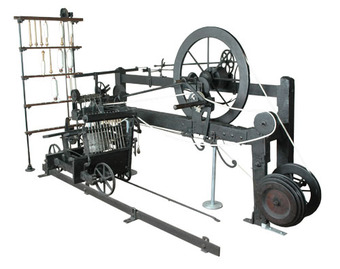
Productivity Technology
The introduction of the spinning mule into cotton production processes helped to drastically increase industry consumption of cotton. This example is the only one in existence made by the inventor Samuel Crompton. It can be found in the collection of Bolton Museum and Archive Service.
10.4: Controlling the Supply Chain
10.4.1: Purchasing
Purchasing is the formal process of buying goods and services.
Learning Objective
Explain the purchasing process
Key Points
- Purchasing directors and procurement directors guide and define the organization’s acquisition procedures and standards.
- Most organizations use a three-way check as the foundation of their purchasing programs. This involves three departments in the organization completing separate parts of the acquisition process.
- The purchasing process usually starts with a demand for a physical part (inventory) or a service. A requisition detailing the requirements is generated (and in some cases provides a requirements speciation) and passed to the procurement department.
- Purchase orders can be of various types: standard, one-time buy, planned (agreement with a specific item at an approximate date), and blanket (an agreement with non-specific date, quantity, and amount).
- Purchase orders are normally accompanied by terms and conditions, which form the contractual agreement of the transaction.
Key Term
- Purchasing
-
Purchasing refers to a business or organization attempting to acquiring goods or services to accomplish the goals of its enterprise.
Example
- Successful supply chain management requires a shift from the management of individual functions to the integration of activities, such as purchasing, into key supply chain processes. For example, a purchasing department will place orders as requirements become known.
Purchasing is the formal process of buying goods and services. Purchasing managers/directors, and procurement managers/directors, guide the organization’s acquisition procedures and standards. The purchasing process can vary from one organization to another but usually involves certain key elements.
Most organizations use a three-way check as the foundation of their purchasing programs. This involves three departments in the organization, each of which completes a different part of the acquisition process. The three departments do not report to the same senior manager, which prevents unethical practices and lends credibility to the process. These departments may be designated as any of the following: purchasing, receiving, accounts payable or engineering, purchasing and accounts payable, or plant management. Combinations vary significantly, but a purchasing department and accounts payable are usually two of the three departments involved.
The purchasing process typically starts with a demand or specific requirements for a physical part (inventory) or a service. A requisition detailing the requirements is generated (and in some cases provides a requirements speciation) and passed to the procurement department. A Request for Proposal (RFP) or Request for Quotation (RFQ) is then produced. Suppliers respond to the RFQ with quotes, and a review is undertaken in order to determine the best offer (a judgment based on price, availability, and quality) and issue the purchase order.
Purchase orders (POs) can be of various types:
- Standard: a one time buy
- Planned: an agreement on a specific item at an approximate date
- Blanket: an agreement on specific terms and conditions (date and quantity and amount are not specified)
POs are normally accompanied by terms and conditions, which represent the contractual agreement of the transaction. The supplier delivers the product and/or service and the customer records the delivery (in some cases, the delivery is accompanied by a goods inspection process). The supplier then issues an invoice that is cross-checked with the purchase order and the record of the product and/or service received. Finally, payment is made.
Successful supply chain management requires an effective shift from the management of individual functions to the integration of activities, such as purchasing, into key supply chain processes. For instance, a purchasing department will place orders as requirements become known.
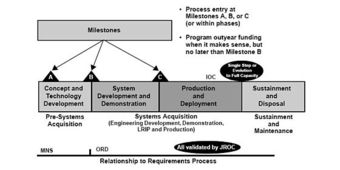
Acquisition Process
Model of the acquisition process for major systems in industry and defense: The process is defined by a series of phases, during which technology is defined and matured into viable concepts, which are subsequently developed and prepared for production.
10.4.2: Inventory Management
Inventory management is primarily concerned with specifying the shape and percentage of stocked goods to reduce costs and improve sales.
Learning Objective
Recognize the applications and benefits of inventory management
Key Points
- Inventory refers to a list compiled for some formal purpose, such as the details of an estate or the contents of a rented house.
- Inventory management is required at different locations within a facility or within many locations of a supply network in order to plan for the production and stock of materials.
- Inventory management addresses issues including: replenishment lead time; carrying costs of inventory; asset management; inventory forecasting; inventory valuation; inventory visibility; and future inventory price forecasting.
- Supply chain activities can be grouped into strategic, tactical, and operational categories.
- Supply chain activities can be grouped into strategic, tactical, and operational levels.
Key Terms
- tactical planning
-
an organization’s process of determining how to optimize current resources and operations
- supply chain
-
A supply chain is a system of organizations, people, technology, activities, information and resources involved in moving a product or service from supplier to customer.
In the United Kingdom, inventory typically refers to a list compiled for some formal purpose, such as one that itemizes an estate going to probate or the contents of a furnished house to be rented. In the U.S. and Canada, inventory has become the equivalent of the British term stock; that is, it refers to material that is available from and stocked by a business. In the context of accounting, inventory or stock is considered an asset.
Inventory Management
Inventory management tracks the shape and percentage of stocked goods. At different locations within a facility, or within many locations of a supply network, inventory management must precede the regular and planned course of production and stocking of materials .
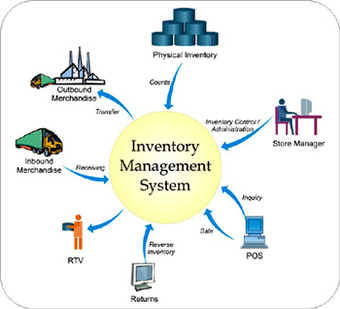
Inventory Management
Inventory management is primarily concerned with specifying the shape and percentage of stocked goods.
Inventory management addresses a number of concerns, including: replenishment lead time; carrying costs of inventory; asset management; inventory forecasting; inventory valuation; inventory visibility; future inventory price forecasting; physical inventory; available physical space for inventory; quality management; replenishment; returns and defective goods; and demand forecasting. By effectively managing these issues, a business can achieve optimal inventory levels. However, the management process is on-going as a business and its needs shift and respond to the wider environment.
Inventory management often involves a retailer seeking to acquire and maintain a proper merchandise assortment while ordering, shipping, handling, and related costs are kept in check. It requires systems and processes that identify inventory requirements, set targets, provide replenishment techniques, report actual and projected inventory status, and handle all functions related to the tracking and management of material. These include the monitoring of material moved into and out of stockroom locations, as well as the reconciling of inventory balances. Processes may also include ABC analysis, lot tracking, and cycle counting support.
Management of inventories, aimed primarily at determining and controlling stock levels within the physical distribution system, serves to balance the need for product availability against the need for minimizing stock holding and handling costs. Reasons for keeping an inventory include:
- Time: The time lag in the supply chain from supplier to user requires the availability of a certain amount of inventory for use during this lead time. In practice, inventory is maintained for consumption during variations in lead time, and lead time itself can be addressed by ordering a specified number of days in advance.
- Uncertainty: Inventories are maintained as buffers to meet uncertainties in demand, supply, and movement of goods.
- Economies of scale: To deliver one unit of product at a time, and in response to the specific need and location of a given user, would be costly and logistically difficult. In contrast, bulk buying, movement, and storage translate into economies of scale and inventory.
Inventory and the Supply Chain
Supply chain activities can be grouped into strategic, tactical, and operational levels. Inventory considerations present at each level include:
Strategic: Network optimization, including the number, location, and size of warehousing, distribution centers, and facilities.
Tactical: Inventory decisions, including quantity, location, and quality of inventory.
Operational: Sourcing planning, including current inventory and forecast demand, done in collaboration with all suppliers; inbound operations, including transportation from suppliers and receiving inventory; outbound operations, including all fulfillment activities, warehousing, and transportation to customers; management of non-moving, short-dated inventory and avoidance of short-dated products.
10.4.3: Scheduling
The purpose of scheduling is to minimize production time and costs.
Learning Objective
Explain the benefits of using modern scheduling tools
Key Points
- Production scheduling aims to maximize the efficiency of operations and reduce costs.
- Benefits of production scheduling include process change-over reduction; inventory reduction; leveling; reduced scheduling effort; increased production efficiency; labor load leveling; accurate delivery date quotes; and real time information.
- Minute-by-minute production scheduling for each manufacturing facility in the supply chain occurs at the operational level of supply chain activities.
- Benefits of production scheduling include process change-over reduction, inventory reduction, leveling, reduced scheduling effort, increased production efficiency, labor load leveling, accurate delivery date quotes and real time information.
- Production scheduling for each manufacturing facility in the supply chain (minute by minute) takes place at the operational level of supply chain activities.
Key Terms
- Backward scheduling
-
Backward scheduling is planning the tasks from the due date or required-by date to determine the start date and/or any changes in capacity required.
- Forward scheduling
-
Forward scheduling is planning the tasks from the date resources become available to determine the shipping date or the due date.
- maturity date
-
the time of the final payment of a loan or other financial instrument, at which point the principal (and all remaining interest) is due to be paid
Example
- In order to reduce costs, an airline may want to minimize the number of airport gates required for its aircraft. Scheduling software allows planners to determine how this might be done, enabling them to analyze time tables, aircraft usage, or the flow of passengers.
Scheduling is an important tool in the manufacturing and engineering industries, where it can significantly impact the productivity of a particular process. In manufacturing, the purpose of scheduling is to minimize production time and cost by telling a production facility when to make a product and with which staff and equipment.
Production scheduling aims to maximize the efficiency of an operation and reduce its costs . Modern scheduling tools greatly outperform older, manual scheduling methods. Today’s tools provide the production scheduler with powerful graphical interfaces, which can be used to visually optimize real time work loads in various stages of production. Further, pattern recognition software reveals scheduling opportunities that might not be apparent without this view into the data.

Scheduling Visualization
This Gantt chart aids in scheduling by visualizing and relating phases of production.
For example, in order to reduce costs, an airline may want to minimize the number of airport gates required for its aircraft. Scheduling software allows planners to see how this might be done, enabling them to analyze time tables, aircraft usage, or the flow of passengers.
Companies use backward and forward scheduling to allocate plant and machinery resources, determine human resources and production processes, and purchase materials. Forward scheduling involves planning tasks from the date that resources become available in order to determine the shipping date or the due date. Backward scheduling involves planning tasks from the due date or required-by date in order to determine the start date and/or necessary changes in capacity.
Production scheduling has a number of benefits:
- Process change-over reduction
- Inventory reduction and leveling
- Reduced scheduling effort
- Increased production efficiency
- Labor load leveling
- Accurate delivery date quotes
- Real time information
Finally, minute-by-minute production scheduling occurs for each manufacturing facility in the supply chain at the operational level of supply chain activities.
10.4.4: Routing
Routing is the process of selecting paths in a network along which to send network traffic.
Learning Objective
Explain the process of routing
Key Points
- Routing is performed for many kinds of networks, including the telephone network (circuit switching), electronic data networks (such as the Internet), and transportation networks.
- A transport network, (or transportation network in American English), is typically a network of roads, streets, pipes, aqueducts, power lines, or nearly any structure which permits either vehicular movement or flow of some commodity.
- Transport engineers use mathematical graph theory to analyze a transport network to determine the flow of vehicles (or people) through it.
- At the tactical level of supply chain activities, the transportation strategy of goods must be considered. This includes frequency, routes, and contracting.
Key Terms
- transport network
-
A transport network, or transportation network in American English, is typically a network of roads, streets, pipes, aqueducts, power lines, or nearly any structure which permits either vehicular movement or flow of somecommodity.
- routing
-
a method of finding paths from origins to destinations in a network such as the Internet, along which information can be passed
Routing is the process of selecting paths in a network along which to send network traffic. Routing is performed for many kinds of networks, including the telephone network (circuit switching), electronic data networks (such as the internet), and transportation networks. This chapter focuses on the role of routing in transportation networks.
Transport Networks
A transport network, (or transportation network in American English), is typically a network of roads, streets, pipes, aqueducts, power lines, or nearly any structure which permits either vehicular movement or flow of some commodity. Transport engineers use mathematical graph theory to analyze a transport network to determine the flow of vehicles (or people) through it. A transport network may combine different modes of transport.
Tactical Level
At the tactical level of supply chain activities, the transportation strategy of goods must be considered. This includes frequency, routes, and contracting of goods. A goal of a company when transporting goods is to ensure efficiency. Wear and tear of vehicles and the cost of gas can make some routes more expensive than others. In order to reduce costs, companies often look for ways to streamline routes and supply chain activities. GPS, or global positioning system, is a technological advancement that has helped companies determine which routes are the most expensive to maintain. These routes can be analyzed to determine if they can be eliminated, divided, and/or merged with other routes, or if finding a new route can help make the route more efficient. Sometimes transport is subcontracted to specialists or logistics partners.

Anycast Routing
A visual display of Anycast routing.
10.4.5: Outsourcing
Outsourcing is the contracting of an existing business process to an external, independent organization.
Learning Objective
Analyze the effects of outsourcing on the supply chain
Key Points
- The specialization model creates manufacturing and distribution networks composed of multiple, individual supply chains specific to products, suppliers, and customers who work together to design, manufacture, distribute, market, sell, and service a product.
- Outsourcing involves not only the procurement of materials and components, but also the outsourcing of services that traditionally have been provided in-house.
- Managing and controlling a network of partners and suppliers requires a blend of both central and local involvement.
- Managing and controlling a network of partners and suppliers requires a blend of both central and local involvement. Hence, strategic decisions need to be taken centrally, with the monitoring and control of supplier performance and day-to-day liaison with logistics partners being best managed at a local level.
Key Term
- supply chain
-
A supply chain is a system of organizations, people, technology, activities, information and resources involved in moving a product or service from supplier to customer.
Example
- In the early 21st century, businesses increasingly outsourced to suppliers outside their own country, sometimes referred to as offshoring or offshore outsourcing.
Outsourcing is the process of contracting an existing business process which an organization previously performed internally to an independent organization, where the process is purchased as a service.

Outsourcing
Outsourcing is the process of contracting an existing business process which an organization previously performed internally to an independent organization, where the process is purchased as a service.
The Rise of Outsourcing
In the 1990s, industries began to focus on “core competencies,” and adopted a specialization model. Companies abandoned vertical integration, sold off non-core operations, and outsourced those functions to other companies. This changed management requirements by extending the supply chain well beyond company walls and distributing management across specialized supply chain partnerships.
This transition also re-focused the fundamental perspectives of each respective organization. OEMs became brand owners that needed deep visibility into their supply base. They had to control the entire supply chain from above instead of from within. Contract manufacturers had to manage bills of material with different part numbering schemes from multiple OEMs and support customer requests for work -in-process visibility and vendor-managed inventory (VMI).
Outsourcing and the Supply Chain
The specialization model creates manufacturing and distribution networks composed of multiple, individual supply chains specific to products, suppliers, and customers who work together to design, manufacture, distribute, market, sell, and service a product. The set of partners may change according to a given market, region, or channel, resulting in a proliferation of trading partner environments, each with its own unique characteristics and demands.
Outsourcing involves not only the procurement of materials and components, but also the outsourcing of services that traditionally have been provided in-house. The logic of this trend is that the company will increasingly focus on those activities in the value chain where it has a distinctive advantage, and outsource everything else. This movement has been particularly evident in logistics, where the provision of transport, warehousing, and inventory control is increasingly subcontracted to specialists or logistics partners. Also, managing and controlling this network of partners and suppliers requires a blend of both central and local involvement. Hence, strategic decisions need to be taken centrally, with the monitoring and control of supplier performance and day-to-day liaison with logistics partners being best managed at a local level.
10.4.6: Logistics
Logistics plans, implements, and controls the forward and reverse flow and storage of goods between the point of origin and consumption.
Learning Objective
Differentiate between supply chain and logistics
Key Points
- Logistics involves the integration of information, transportation, inventory, warehousing, material handling, and packaging, and often security. Today, the complexity of production logistics can be modeled, analyzed, visualized, and optimized by plant simulation software but is constantly changing.
- Logistics applies to activities within one company involving distribution of the product, whereas the term “supply chain” also encompasses manufacturing and procurement and, therefore, has a much broader focus.
- Logistics as a business concept evolved in the 1950s due to the increasing complexity of supplying businesses with materials and shipping out products in an increasingly globalized supply chain, leading to a call for experts called “supply chain logisticians”.
- In business, logistics may have either internal focus (inbound logistics) or external focus (outbound logistics), covering the flow and storage of materials from point of origin to point of consumption (see supply chain management).
- There are two fundamentally different forms of logistics. One optimizes a steady flow of material through a network of transport links and storage nodes, and the other coordinates a sequence of resources to carry out some project.
- There are two fundamentally different forms of logistics: one optimizes a steady flow of material through a network of transport links and storage nodes; the other coordinates a sequence of resources to carry out some project.
Key Terms
- inventory
-
The stock of an item on hand at a particular location or business.
- supply chain
-
A system of organizations, people, technology, activities, information. and resources involved in moving a product or service from supplier to customer.
- logistics
-
The process of planning, implementing, and controlling the efficient, effective flow and storage of goods, services, and related information from their point of origin to point of consumption for the purpose of satisfying customer requirements.
Logistics
The term Logistics Management or Supply Chain Management is the part of Supply Chain Management that plans, implements, and controls the efficient, effective, forward, and reverse flow and storage of goods, services, and related information between the point of origin and the point of consumption in order to meet customer’s requirements.
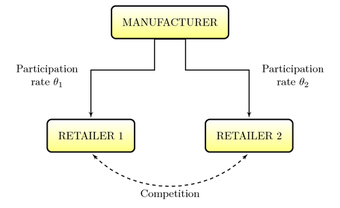
Distribution chain
Example of how companies may be supplied by the same distributor.
Logistics involves the integration of information, transportation, inventory, warehousing, material handling, and packaging, and often security. Today, the complexity of production logistics can be modeled, analyzed, visualized, and optimized by plant simulation software but is constantly changing. This can involve anything from consumer goods, such as food to IT materials, and aerospace and defense equipment.
There is often confusion over the terms “supply chain” and “logistics. ” It is now generally accepted that the logistics applies to activities within one company/organization involving distribution of product, whereas supply chain also encompasses manufacturing and procurement and, therefore, has a much broader focus as it involves multiple enterprises, including suppliers, manufacturers, and retailers, working together to meet a customer’s need for a product or service.
The Evolution of Logistics
Logistics as a business concept evolved in the 1950s due to the increasing complexity of supplying businesses with materials and shipping out products in an increasingly globalized supply chain, leading to a call for experts or supply chain logisticians. Business logistics can be defined as “having the right item in the right quantity at the right time at the right place for the right price in the right condition to the right customer,” and is the science of process and incorporates all industry sectors. The goal of logistics work is to manage the fruition of project life cycles, supply chains, and resultant efficiencies.
Starting in the 1990s, several companies chose to outsource the logistics aspect of supply chain management by partnering with a 3PL, third-party logistics provider. Companies also outsource production to contract manufacturers. Technology companies have risen to meet the demand to help manage these complex systems.
Logistic Focus
In business, logistics may have either an internal focus (inbound logistics) or external focus (outbound logistics).
Inbound logistics is one of the primary processes of logistics, concentrating on purchasing and arranging the inbound movement of materials, parts, and/or finished inventory from suppliers to manufacturing or assembly plants, warehouses, or retail stores.
Outbound logistics is the process related to the storage and movement of the final product and the related information flows from the end of the production line to the end user.
10.4.7: Quality Control
Quality control is a process that evaluates output against a standard and takes corrective action when output doesn’t meet that standard.
Learning Objective
Discuss the role of quality control in business
Key Points
- The purpose of quality control is to make sure that certain processes perform to a company’s set standards.
- Quality control in relation to customers involves the continuous act of making sure products, designed and manufactured, are produced to meet and exceed customer needs.
- Quality should be measured differently for products and services and judged by their own set of dimensions.
- Controls include product inspection, where every product is visually examined, often with a stereo microscope to perceive fine detail before the product is sold into the external market.
- Responsibility for overall quality lies with top management. Top management must establish strategies, institute programs for quality, and motivate managers and workers.
Key Terms
- quality control
-
A control, such as inspection or testing, introduced into an industrial or business process to ensure quality.
- organizational culture
-
Organizational culture is the collective behavior of humans who are part of an organization and the meanings that the people attach to their actions.
- total quality management
-
A strategic approach to management aimed at embedding awareness of quality in all organizational processes.
Example
- Controls include product inspection, where every product is examined visually. Inspectors will be provided with lists and descriptions of unacceptable product defects such as cracks or surface blemishes.
Quality can be thought of as the degree to which performance of a product or service meets or exceeds expectations. Quality control is a process that evaluates output against a standard and takes corrective action when output doesn’t meet these predetermined standards. Therefore, quality control in relation to customers would be the continuous act of making sure products, designed and manufactured, are produced to meet and exceed the needs of customers. For contract work, particularly work awarded by government agencies, quality control issues are among the top reasons for not renewing a contract .
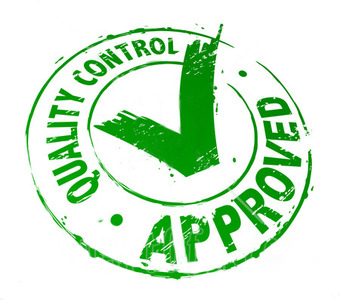
quality control
The purpose of quality control is to make sure that certain processes are performing up to a company’s set standards.
This approach places an emphasis on three aspects:
- Elements such as controls, job management, defined and well-managed processes, performance and integrity criteria, and identification of records
- Competence, such as knowledge, skills, experience, and qualifications
- Soft elements, such as personnel integrity, confidence, organizational culture, motivation, team spirit, and quality relationships
Controls include product inspection, where every product is examined visually, often using a stereo microscope for fine detail before the product is sold on the external market. Inspectors will be provided with lists and descriptions of unacceptable product defects such as cracks or surface blemishes.
An emphasis on quality control heightened during World War II. At that time quality control evolved to quality assurance and is now better known as a Strategic Approach, a tool for improving not only products but also processes and services. Quality should be measured differently for products and services, and judged by their own set of dimensions. Responsibility for overall quality lies with top management. Top management must establish strategies, institute programs for quality, and motivate managers and workers. Most of the time, managers aim to improve or maintain the quality of an organization as a whole; this is referred to as Total Quality Management (TQM). TQM involves a continual effort for quality improvement by everyone in an organization. The entire supply chain must be involved for an organization to meet and exceed goals of quality control.
10.4.8: Investment in Operations
Investment in information technology has made supply chains faster, cheaper, and more reliable.
Learning Objective
Examine the effect of technological advances on supply chain optimization
Key Points
- Supply chain optimization applies processes and tools that ensure the optimal operation of a manufacturing and distribution supply chain.
- Supply chain managers try to maximize the profitable operation of their manufacturing and distribution supply chain.
- Supply chain optimization may include refinements at various stages of the product lifecycle, and new, ongoing, and obsolete items are optimized in different ways.
- Optimization solutions are typically part of, or linked to, the company’s replenishment systems distribution requirements planning, so that orders can be automatically generated to maintain the model stock profile. The algorithms used are similar to those used in making financial investment decisions; the analogy is quite precise, as inventory can be considered to be an investment in prospective return on sales.
- Supply chain optimization may include refinements at various stages of the product lifecycle, so that new, ongoing and obsolete items are optimized in different ways: and adaptations for different classes of products, for example seasonal merchandise.
Key Term
- supply chains
-
A supply chain is a system of organizations, people, technology, activities, information and resources involved in moving a product or service from supplier to customer.
Example
- Because the movement of product (called the stock transfer) needs to be in economic shipping units (i.e., complete unit loads or full truckloads), a series of decisions must be made. Many existing distribution planning systems round quantities up to the nearest full shipping unit. The creation of truckloads, for example, as economic shipping units requires optimization systems that ensure that axle constraints and space constraints are met, and that loading can be achieved in a damage-free way. These goals are generally achieved by adding time-phased requirements until loads meet a specified minimum weight or cube.
Supply chains have become faster, cheaper, and more reliable through investment in information technology, cost-analysis, and process-analysis.
Supply chain optimization applies processes and tools that ensure optimal operation of a manufacturing and distribution supply chain. These include the optimal placement of inventory within the supply chain and the minimizing of operating costs associated with manufacturing, transportation, and distribution. Optimization may also incorporate computer-based mathematical modelling techniques .
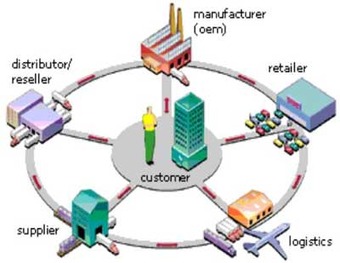
Supply Chain
Supply chain optimization applies processes and tools that ensure the optimal operation of a manufacturing and distribution supply chain.
Ongoing investment in a company’s operations is necessary in order for supply chain optimization to be achieved. Supply chain managers may employ optimization such as maximizing gross margin return on inventory invested (GMROII); balancing the cost of inventory at all points in the supply chain with availability to the customer; minimizing total operating expenses (e.g., transportation, inventory, and manufacturing); and maximizing gross profit of products distributed through the supply chain.
Supply chain optimization addresses the general supply chain problem of delivering products to customers at low cost and high profit. This involves balancing the costs of inventory, transportation, distribution, and manufacturing, and supply chain optimization has applications in all industries that manufacture and/or distribute goods (retail, industrial, and/or consumer packaged goods [CPG]).
The classic supply chain approach has been to forecast future inventory demand using statistical trending and “best fit” techniques, which are based on historic demand and predicted future events. The advantage of this approach is that it can be applied to data aggregated at a fairly high level (e.g., category of merchandise; weekly, by customer category), thus requiring modest database sizes and small amounts of manipulation. Unpredictability in demand is subsequently managed by setting safety stock levels; for example, a distributor might hold two weeks of supply for a steadily in-demand article but twice that supply for an article whose demand is more erratic.
Using this forecast demand, a supply chain manufacturing and distribution plan is created to manufacture and distribute products to meet the demand at low cost and/or high profit. This plan typically addresses several questions:
- How much of each product should be manufactured each day?
- How much of each product should be made at each manufacturing plant?
- Which manufacturing plants should re-stock which warehouses with which products?
- What transportation modes should be used for warehouse replenishment and customer deliveries?
The technical ability to record and quickly manipulate large databases has allowed for the emergence of a new breed of supply chain optimization solutions, which are capable of forecasting at a granular level (for example, per article per customer per day). Some vendors are applying “best fit” models to this data, to which safety stock rules are applied, while other vendors have started to apply stochastic techniques to the optimization problem.
Supply chain optimization may include additional refinements at various stages of the product lifecycle, and new, ongoing, and obsolete items are optimized in different ways. Finally, while most software vendors are offering supply chain optimization as a packaged solution and integrated in ERP software, some vendors are running the software on behalf of clients as application service providers.
10.5: Planning for Operations
10.5.1: New Product Development
Organizations put a lot of time and money into new products and thus deploy various methods in an attempt to mitigate the risks.
Learning Objective
Distinguish between minimum viable product, continuous deployment, split testing, vanity metrics, laboratory tests, expert evaluations and customer evaluations
Key Points
- Organizations use formal systems to evaluate new products.
- Product testing and sales forecasts are used to help diminish the risk of introducing a new product.
- It’s possible to eliminate some of the risks associated with introducing a new product by launching the smallest amount of the product possible to test demand.
- Several methods can be used to evaluate new products before they are launched.
Key Terms
- product differentiation
-
perceived differences between the product of one firm and that of its rivals so that some customers value it more
- product
-
Any tangible or intangible good or service that is a result of a process and that is intended for delivery to a customer or end user.
- minimum viable product
-
The minimum viable product is a product stripped down to it’s most basic, necessary features in order to get that product into the consumer’s hands in the quickest, most affordable way.
- product placement
-
a form of advertising where a brand, good, or service is placed in the media, for money
Example
- The birth of Zappos provides an example of how an organization can release the smallest amount of the product possible to collect the maximum amount of validated learning about customers with the least amount of effort (a minimum valuable product). Zappos founder Nick Swinmurn wanted to test the hypothesis that customers were ready and willing to buy shoes online. Instead of building a website and a large database of footwear, Swinmurn approached local shoe stores, took pictures of their inventory, posted the pictures online, bought the shoes from the stores at full price, and sold them directly to customers if they purchased the shoe through his website. Swinmurn deduced that customer demand was present, and Zappos would eventually grow into a billion dollar business based on the model of selling shoes online.
Introduction
Organizations invest a lot of money to create new products that perform effectively. Nonetheless, firms often struggle to convince people to incorporate these new products into their routines (Arts 2008). For example, it took 18 years for microwave ovens to gain acceptance in Greece (Tellis, Stremersch, and Yin 2003). The ultimate success of new products depends on consumers accepting them (Arts 2008). .

New product
Organizations invest a lot of money to create new products that perform effectively.
Product Evaluation
The term “product” refers to both goods and services. A product is anything that can be offered to a market to satisfy a want or need. When an organization adds a new product, there is both potential benefit and risk. As a result, organizations implement formal systems for evaluating new products. In particular, there is a concerted effort to forecast projected sales and thus reduce some of the financial risk.
While evaluating new products, there is also the possibility of generating innovative ideas that can later go through the testing process. Idea generation is an essential part of marketing strategy and is critical to the success of a company. When such product ideas move further along, a key step is to create a prototype or working version of the new offering. Again, market testing is crucial at every stage in the development process.
Minimum Viable Product
A minimum viable product (MVP) is the “version of a new product which allows a team to collect the maximum amount of validated learning about customers with the least effort. ” The goal of an MVP is to test fundamental business hypotheses (or leap-of-faith assumptions) and to help entrepreneurs begin the learning process as quickly as possible.
For example, Ries notes that Zappos founder Nick Swinmurn wanted to test the hypothesis that customers were ready and willing to buy shoes online. Instead of building a website and a large database of footwear, Swinmurn approached local shoe stores, took pictures of their inventory, posted the pictures online, bought the shoes from the stores at full price, and sold them directly to customers if they purchased the shoe through his website. Swinmurn deduced that customer demand was present, and Zappos would eventually grow into a billion-dollar business based on the model of selling shoes online.
Continuous Deployment
Continuous deployment is a process “whereby all code that is written for an application is immediately deployed into production,” resulting in a reduction of cycle times. Ries states that some of the companies he’s worked with deploy new code into production as often as 50 times a day. The phrase was coined by Timothy Fitz, one of Ries’s colleagues and an early engineer at IMVU.
Split Testing
A split test or A/B test is an experiment in which “different versions of a product are offered to customers at the same time. ” The goal of a split test is to observe changes in behavior between the two groups and to measure the impact of each version on an actionable metric. A/B testing can also be performed in serial fashion where a group of users one week may see one version of the product while the next week users see another.
Vanity Metrics
Vanity metrics are measurements which give “the rosiest picture possible” but do not accurately reflect the key drivers of a business. This is in contrast to actionable metrics, the measurement of which can lead to a business decision and subsequent action.
Laboratory Tests
Laboratory tests provide information regarding the performance of new products in extreme settings. For example, a new copy machine can be tested at various work loads, like numbers of copies and speed per minute to test the relationship between workload and paper jam.
Expert Evaluations
Expert evaluators can be used at all phases of the new product development process. For instance, experts can be used to estimate whether or not a new product idea will be accepted in the marketplace before a prototype even exists.
Customer Evaluations
In later stages of development, customers can be recruited to evaluate prototypes. There is an attempt to test new products under conditions that are relatively close to actual use.
10.5.2: Designing the Operation
Designing effective operations is critical, and can have both short-term and long-term impacts on an organization’s longevity.
Learning Objective
Explain the importance of operations management on the success of a business
Key Points
- Operations management is a strategic function within an organization.
- Operations decisions include elements needed to produce goods and services, and make them available to customers.
- Operations management touches upon multiple areas of a business, from engineering and research & development, to human resources and accounting.
Key Terms
- operation
-
The method or practice by which actions are done.
- Operations management
-
An area of management concerned with overseeing, designing, controlling the process of production, and redesigning business operations in the production of goods and/or services.
Designing the Operation
Operations management is a strategic function in organizations that adds value to customers and allows businesses to successfully produce goods and deliver services. Operational decisions determine how well these goods and services meet the needs of the organization’s target market, and consequently, whether the organization will be able to survive over the long-term .

Smooth Landing
Operations management plays a key role in the success in airline companies.
If the organization has made mostly good operational decisions in designing and executing its transformation system to meet the needs of customers, its prospects for long-term survival are greatly enhanced.
Operations management and planning are common in industries such as the airlines, manufacturing companies, service provider organizations, the military, and government. Some examples of management and planning include:
- Scheduling airlines, including both planes and crew
- Deciding the appropriate place to site new facilities such as a warehouse, factory, or fire station
- Managing the flow of water from reservoirs; identifying possible future development paths for parts of the telecommunications industry
- Establishing the information needs and appropriate systems to supply them within the health service
- Identifying and understanding the strategies adopted by companies for their information systems
Operational Decisions
As mentioned, operations decisions have both long-term and short-term impacts on the organization’s ability to produce goods and services, and can provide added value to customers and employees. Operations management touches upon multiple areas of a business, from engineering and research & development, to human resources and accounting. Likewise, the decisions management makes when parceling technological, monetary, and people resources across the organization typically falls under the following areas:
- Inventory decisions
- Capacity decisions
- Quality decisions
- Scheduling decisions
- Process decisions
- Technology decisions
- Location decisions
Most often when a company sets operational goals and objectives, they are considered relatively short term.
10.5.3: Capacity Planning
Capacity planning revolves around answering the question “How much? ” in both long-term and short-term situations.
Learning Objective
Compare and contrast long-term and short-term capacity decisions
Key Points
- Capacity planning takes place on a daily basis in some industries.
- Organizations must closely examine the services and the cost of services offered to their customers when making capacity decisions.
- In a grocery store or supermarket, managers must ensure that sufficient cash registers and employees are on-hand to meet check-out demand and provide good customer service.
Key Term
- capacity
-
The maximum that can be produced on a machine or in a facility or group.
Introduction
When making capacity decisions, managers must answer the simple question, “How much?” Determining the organization’s capacity to produce goods and services involves both long-term and short-term decisions. Long-term capacity decisions involve facilities and major equipment investments .
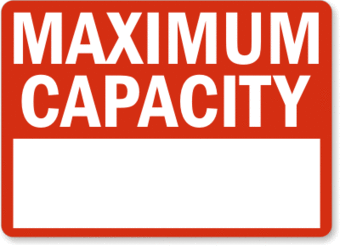
capacity
The question managers must answer for capacity decisions is simply “How much?”
Long-term decisions
In 2007, Airbus introduced its Super Jumbo Jet that carries up to 850 passengers and costs USD 3 billion. The Super Jumbo Jet provides huge amounts of passenger carrying capacity, but before an airline purchases this jet, it needs to decide if it has enough passengers to generate the revenue to pay for the plane and earn profits for the airline. Buying a large single airplane like the Super Jumbo Jet may not be the right capacity decision for an airline that serves numerous medium-sized cities. On the other hand, an airline that serves passengers traveling between large cities like New York City, USA, and Shanghai, China might find the Super Jumbo Jet to be a perfect choice for meeting consumer demand.
Short-term decisions
Capacity decisions are also required in short-term situations. In a grocery store, the number of customers that need to pay for their groceries at any one point during the day will vary significantly. To provide good customer service, managers must make sure that sufficient cash registers and employees are on-hand to meet check-out demand at any given time.
Similarly, hotels must make sure that they have enough employees to register arriving guests, clean hotel rooms, and provide food and beverages to customers. These decisions must be made carefully to avoid excessive labor costs that result from having an excess of employees available for the number of customers being served.
10.5.4: Facilities Layout
Facility layout decisions are based on criteria aimed at creating an effective and efficient workflow and high standard production.
Learning Objective
Outline the key considerations in facility design
Key Points
- There are three types of workflow layouts that managers can choose from.
- Office and factory facilities are approached differently.
- A facility manager’s industry can also influence the facilities layout design.
Key Term
- facilities layout
-
Facility layout is simply the way a facility is arranged in order to maximize processes that are not only efficient but effective towards the overall organizational goal.
Examples
- A paper mill is a good example of a repetitive process. The manufacturing requirements are well-understood, capital investment in automation is high, and production volume is extremely high to keep unit production costs as low as possible.
- Health care clinics provide a good example of an intermittent process. X-ray equipment and technicians are organized into an “X-ray Department”. Other departments are created for pediatrics, lab, gynecology, pharmacy, physical therapy, and many more. Patients are routed only to the departments that are needed for their particular treatment requirements.
Introduction
Facilities is defined as the workspace and equipment needed to carry out the operations of the organization. This includes offices, factories, computers, and trucks.
The location, design, and layout of an organizations’ facilities are central to maximising the efficiency of the overall operations system.
In this unit, we’re going to focus on facility design and layout.
Facilities Design and Layout
After choosing the facility’s location, the next stage in operations planning is to design the best physical layout for the facility. The avaliable space needs to be assessed with workstations, equipment, storage, and other amenities need to be arranged. The aim is to allow for the most efficient workflow without disruption. A workplace that has carefully arranged its layout will allow for a more effictive and efficient workflow and produce its good or services to a high standard.
There are three types of workflow layouts that managers can choose from:
- Process layout: arranged in departments (e.g., hospitals).
- Product layout: production line (e.g., a car assembly plant).
- Fixed-position layout: building a large item (e.g., jumbo jet).
Facility Layout Considerations
Facility managers should consider several factors when designing the layout of a facility to achieve maximum effectiveness.
- Does the design and layout allow for growth or change? Is there a chance that your company will experience significant growth? Could some other change come about that could influence the layout of your facility? In business, anything is possible. Make sure that same is true of your facilities layout. While making changes is a costly and undertaking them shouldn’t be taken lightly, your layout should be flexible enough to allow a redesign if the situation calls for it.
- Is the process flow smooth? If you are running a factory, for example, the flow should be such that the raw materials enter at one end and the finished product exits at the other. The flow doesn’t have to form a straight line, but there should be no backtracking. Backtracking creates confusion. Employees get confused (“Has that been done yet? “), parts get lost, and coordination is very difficult. You need to have a smooth process to be efficient.
- Are materials being handled efficiently? Here simplicity is best.
- Does the facility layout aid the business in meeting its production needs? Is there enough space and is it used efficiently? Have you allowed enough space for shipping and receiving? Can different areas of the business communicate effectively? Does the layout lend itself to promotional activities? (e.g., showing the facilites to potential customers)
- Does the layout contribute to employee satisfaction and moral? Numerous studies have linked employee moral to productivity. So managers should take this point into consideration when designing the layout of their facilities. How can this be done? Paint the walls light colors, allow for windows and space, include a cafeteria and a gym. Some of the options may cost lots of money, but if it increases productivity in the long run, it is probably worth making the investment.
Are the Facilities for an Office or a Factory?

Office Space
An office will have different layout requirements than a factory.
Office and factory facilities are approached differently.
Factories move materials from point A to point B to produce a final products. The process uses equipment and utilities. Minimizing transportation costs may be one of the criteria of planning the layout of a factory. Another important consideration for factories in the necessity for maintenance of machinery. As such, careful consideration of enabling access to technicians is critical to ensuring minimal workflow disruptions in a scenario of updating, repairing or replacing machinery.
Offices, on the other hand, produces information. The form may be physical, electronic, or oral, but the the final result is still information. Office facility layout is harder to quantify than factory facilities layout, but the goal should be to minimize communication costs and maximize productivity.
Your industry can also influence the facilities layout design. The facility layout for service industries will differ from that of retailers and manufacturers. It all depends on organization’s needs.
10.5.5: Location Choice and Site Planning
An organization’s location choice impacts its efficiency and effectiveness, so it is important for it to properly weigh the various factors.
Learning Objective
Outline the key considerations for deciding the location of facilities
Key Points
- There are many factors that can determine where an organization will locate its facilities. For any given situation, some factors become more important than others in how facility location affects an organization’s efficiency and effectiveness.
- The factors determining where a company chooses to locate its facilites include supply, customer, community, and labor considerations.
- An essential part of choosing a location is doing proper research to verity that the location matches an organization’s strategic requirements.
Key Term
- facility
-
The physical means or contrivances to make something (especially a service) possible; the required equipment, infrastructure, location etc.
Example
- The following shows the importance of researching a location choice to make sure it is in line with strategic requirements. In the 1990s, MCI, a major US telecommunications company, decided to relocate its engineering services division from MCI’s headquarters in Washington DC to Colorado Springs, Colorado to reduce labor and facility costs. The decision was largely unsuccessful due to the high costs of employee relocation and the fact that much of the ethnically diverse engineering workforce did not want to live in Colorado Springs. Unlike Washington DC, Colorado Springs did not have cultural diversity to match with its diverse and highly educated workforce, it lacked employment options for spouses, and the work ethic was more relaxed due to the beautiful natural setting that provided unlimited options for outdoor recreation. In short, if MCI had put more effort into researching how well the Colorado Springs location matched its strategic requirements, it probably could have saved itself millions of dollars and a great deal of internal disruption to the organization.
Introduction
There are many factors that can determine where an organization will locate its facilities. For any given situation, some factors become more important than others in how facility location affects an organization’s efficiency and effectiveness.
Key Factors
- Proximity to sources of supply: Firms that process bulk raw materials usually locate close to the source of supply to reduce transportation costs. Paper mills locate close to forests, canneries are built close to farming areas, and fish processing plants are located close to the harbors where the fishing vessels dock.
- Proximity to customers: There are several reasons why an organization would locate close to end customers. Service firms need to be close to customers to be convenient, as is the case for grocery stores, gas stations, fast food restaurants, and hospitals. Transportation costs can also require proximity to customers, as in the case of concrete manufacturing. Perishable products often require that they be produced close to the final market, as is the case for bakeries and fresh flowers.
- Community factors: Communities may offer a number of incentives to entice companies, including waiving or reducing taxes, and providing access roads, water and sewer connections, and utilities. Community attitudes can also play a role in an organization’s location decision. Some communities may actively discourage companies that might bring more pollution, noise, and traffic to the area. Some communities may not want a prison to be located in their community. Other communities may welcome such firms because of the jobs, tax revenues, and economic diversity they promise.
- Labor factors: Research shows that the majority of location decisions are largely based on labor factors, since labor is a critical variable for many firms. Labor factors include the prevailing wage rate in a community for similar jobs, the supply of qualified workers, and the average education level of the local population (percentage of high school graduates, etc.). Other labor factors can include the degree of union organizing and the general work ethic of a community, as well as other measures of absenteeism, and worker longevity in a job can play a strong role when a firm makes a location decision.
- Other factors: Many other factors can play a role in the location decision, including quality of life (crime rates, good schools, climate, and recreation options), access to major transportation arteries, construction costs, proximity of the competition, and opportunities for future expansion.
As mentioned earlier, the importance of any location factor can vary greatly, depending on the circumstances of the decision.

Colorado river
Colorado is beautiful, but it might not be the best location for all organizations.
In the 1990s, MCI, a major US telecommunications company, decided to relocate its engineering services division from MCI’s headquarters in Washington DC to Colorado Springs, Colorado to reduce labor and facility costs. The decision was largely unsuccessful due to the high costs of employee relocation and the fact that much of the ethnically diverse engineering workforce did not want to live in Colorado Springs.
Unlike Washington DC, Colorado Springs did not have cultural diversity to match with its diverse and highly educated workforce, it lacked employment options for spouses, and the work ethic was more relaxed due to the beautiful natural setting that provided unlimited options for outdoor recreation.
In short, if MCI had put more effort into researching how well the Colorado Springs location matched its strategic requirements, it probably could have saved itself millions of dollars and a great deal of internal disruption to the organization.
10.5.6: Sustainability Initiatives
Sustainability initiatives consider every dimension of how a business operates in the social, cultural, and economic environment.
Learning Objective
Explain the principles of corporate sustainability
Key Points
- Transparency deals with the idea that having an engaging and open environment within the company, as well as the community, will improve performance and increase profits.
- Employee development involves the idea that people are the most important renewable resource and, therefore, are the strongest asset to any organization.
- Resource efficiency refers to that fact that companies must adapt to a rapidly changing environment by being prepared to change and implement new creative ideas related to sustainability.
- Essential principles of a sustainability initiative include triple top-line value production, nature-based knowledge and technology, products of service and products of consumption, renewable energy, local economies, and continuous improvement.
Key Terms
- sustainability
-
The capacity to support, maintain, or endure.
- stewardship
-
The act of caring for or improving with time.
- geothermal
-
Pertaining to heat energy extracted from reservoirs in the earth’s interior.
Example
- The following shows the importance of researching a location choice to make sure it is in line with strategic requirements. In the 1990s, MCI, a major US telecommunications company, decided to relocate its engineering services division from MCI’s headquarters in Washington DC to Colorado Springs, Colorado to reduce labor and facility costs. The decision was largely unsuccessful due to the high costs of employee relocation and the fact that much of the ethnically diverse engineering workforce did not want to live in Colorado Springs. Unlike Washington DC, Colorado Springs did not have cultural diversity to match with its diverse and highly educated workforce, it lacked employment options for spouses, and the work ethic was more relaxed due to the beautiful natural setting that provided unlimited options for outdoor recreation. In short, if MCI had put more effort into researching how well the Colorado Springs location matched its strategic requirements, it probably could have saved itself millions of dollars and a great deal of internal disruption to the organization.
Sustainability, in a general sense, is the capacity to support, maintain, or endure. Since the 1980s, human sustainability has been related to the integration of environmental, economic, and social dimensions towards global stewardship and responsible management of resources .
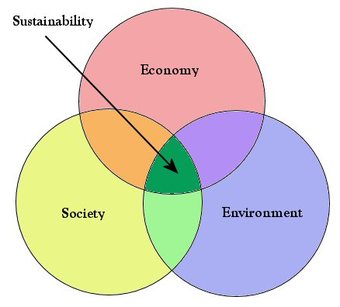
Sustainability
Sustainability is related to the integration of environmental, economic, and social dimensions towards global stewardship and responsible management of resources.
Corporate sustainability is a business approach that creates long-term consumer and employee value by not only creating a “green” strategy aimed towards the natural environment, but taking into consideration every dimension of how a business operates in the social, cultural, and economic environment. It also involves formulating strategies to build a company that fosters longevity through transparency and proper employee development. Three key principles that should form the foundation of a corporate sustainability initiative are: transparency, employee development, and resource efficiency.
Transparency deals with the idea that having an engaging and open environment within the company, as well as the community, will improve performance and increase profits. An open culture promotes employee involvement in regards to the innovation and creative processes. Reaching out to the community creates a much bigger team and provides evaluation from all angles. Companies are looking inward and realizing changes must be made to fulfill environment needs such as energy efficiency, limiting product waste and toxicity, and designing innovative products.
Employee development involves the idea that people are the most important renewable resource and, therefore, are the strongest asset to any organization. A strong development program could be the underlying factor for a company’s success or failure. Employees are the concrete foundation for the company and must be thoroughly analyzed and evaluated to tap into their true motivations and desires. For a company that wants to reach its greatest potential, employees must work towards improvement rather than perfection. Programs should be implemented that reward star performers, foster the creative learning process, and provide comprehensive training and evaluating.
Resource efficiency refers to that fact that companies must adapt to a rapidly changing environment by being prepared to change and implement new creative ideas related to sustainability. Companies should not throw away old products and materials, but rather be prepared with upgraded technology that can transform the product. New solutions that improve recycling and waste redirecting can ultimately reduce costs and increase profits. For example, Wal-Mart Stores Inc. has redirected more than 64% of the waste generated by stores and Sam’s Club facilities. In 2009 alone, they recycled more than 1.3 million pounds of aluminum, 120 million pounds of plastics, 11.6 million pounds of mixed paper, and 4.6 billion pounds of cardboard. On an annual basis, they expect to save around $20 million and prevent 38 million pounds of waste being sent to landfills.
Essential Principles of a Sustainability Initiative
- Triple top-line value production: This establishes three simultaneous requirements of sustainable business activities: 1) financial benefits for the company, 2) natural world betterment, and 3) social advantages for employees and members of the local community—with each of these three components recognized as equal in status.
- Nature-based knowledge and technology: This biomimicry-based principal involves the conscious emulation of natural-world genius in terms of growing our food, harnessing our energy, construction, conducting business, healing ourselves, processing information, and designing our communities.
- Products of service and products of consumption: Products of service are durable goods routinely leased by the customer that are made of technical materials and are returned to the manufacturer and re-processed into a new generation of products when they are worn out. Products of consumption are shorter lived items made only of biodegradable materials. This principal requires that we manufacture only these two types of products and necessitates the gradual but continual reductions of products of service and their replacement with products of consumption as technological advancements allow.
- Solar, wind, geothermal, and ocean energy: This principal advocates employing only sustainable energy technology—solar, wind, ocean, and geothermal—that can meet our energy needs indefinitely without negative effects for life on Earth.
- Local-based organizations and economies: This principle calls for durable, beautiful, and healthy communities with locally-owned and operated businesses and locally-managed non-profit organizations, along with regional corporations and shareholders working together in a dense web of partnerships and collaborations.
- Continuous improvement process: This principle suggests that operational processes inside successful organizations include provisions for constant advancements and upgrade as the company does its business.
